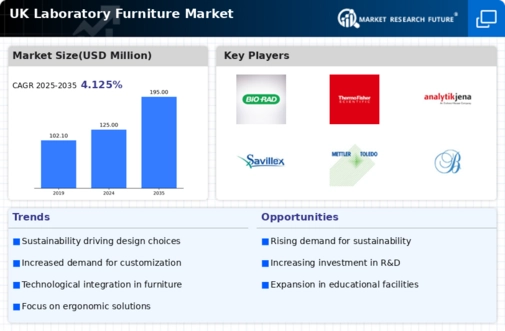Regulatory Compliance and Safety Standards
The laboratory furniture market is significantly influenced by stringent regulatory compliance and safety standards imposed by various governing bodies in the UK. Laboratories are required to adhere to specific guidelines regarding the materials and designs used in their furniture to ensure safety and functionality. This includes the use of non-toxic materials and designs that facilitate easy cleaning and maintenance. As a result, manufacturers are compelled to innovate and produce furniture that meets these regulations, which can lead to increased costs but also enhances market growth. The demand for compliant laboratory furniture is expected to rise, as institutions prioritize safety and regulatory adherence. Consequently, the laboratory furniture market is anticipated to expand, with an estimated growth rate of 4% annually as laboratories invest in compliant solutions.
Growing Focus on Customization and Aesthetics
The laboratory furniture market is characterized by a focus on customization and aesthetics. Laboratories are no longer viewed solely as functional spaces; instead, there is a rising trend to create environments that are visually appealing and tailored to specific needs. This shift is driven by the recognition that a well-designed laboratory can enhance productivity and employee satisfaction. Manufacturers are responding by offering customizable solutions that allow laboratories to select materials, colors, and configurations that align with their branding and operational requirements. This trend is particularly relevant in academic and corporate research settings, where the laboratory environment plays a crucial role in attracting talent. As a result, the laboratory furniture market is likely to experience a growth rate of around 5% as customization becomes a key selling point.
Sustainability Initiatives in Laboratory Design
The laboratory furniture market is increasingly influenced by sustainability initiatives in laboratory design. There is a growing awareness of the environmental impact of laboratory operations, prompting institutions to seek furniture made from sustainable materials and designed for energy efficiency. This trend aligns with broader environmental goals in the UK, where organizations are striving to reduce their carbon footprint. Manufacturers are responding by developing eco-friendly furniture options that utilize recycled materials and sustainable production processes. The demand for such products is expected to rise, as laboratories aim to meet sustainability targets. Consequently, the laboratory furniture market may witness a growth of approximately 4% as more facilities adopt sustainable practices in their design and operations.
Increased Investment in Research and Development
The laboratory furniture market is benefiting from increased investment in research and development (R&D) across various sectors, including pharmaceuticals, biotechnology, and academic institutions in the UK. As organizations allocate more resources to R&D, the demand for high-quality laboratory furniture that supports complex experiments and processes is on the rise. This trend is particularly evident in the pharmaceutical sector, where the need for specialized furniture that accommodates advanced laboratory techniques is critical. The UK government has also been promoting R&D initiatives, which further stimulates the market. It is estimated that the laboratory furniture market could see a growth of approximately 6% as more facilities are established and existing ones are upgraded to meet the demands of modern research.
Technological Advancements in Laboratory Equipment
The laboratory furniture market is experiencing a notable shift due to rapid technological advancements in laboratory equipment. Innovations such as smart lab furniture, which integrates technology for enhanced functionality, are becoming increasingly prevalent. This trend is driven by the need for improved efficiency and safety in laboratory environments. For instance, the incorporation of digital monitoring systems in laboratory furniture allows for real-time data collection and analysis, which is crucial for research and development. The UK market is projected to grow as laboratories seek to upgrade their facilities with state-of-the-art furniture that supports advanced equipment. As a result, the laboratory furniture market is likely to see a compound annual growth rate (CAGR) of around 5% over the next few years, reflecting the increasing demand for technologically integrated solutions.
























Leave a Comment